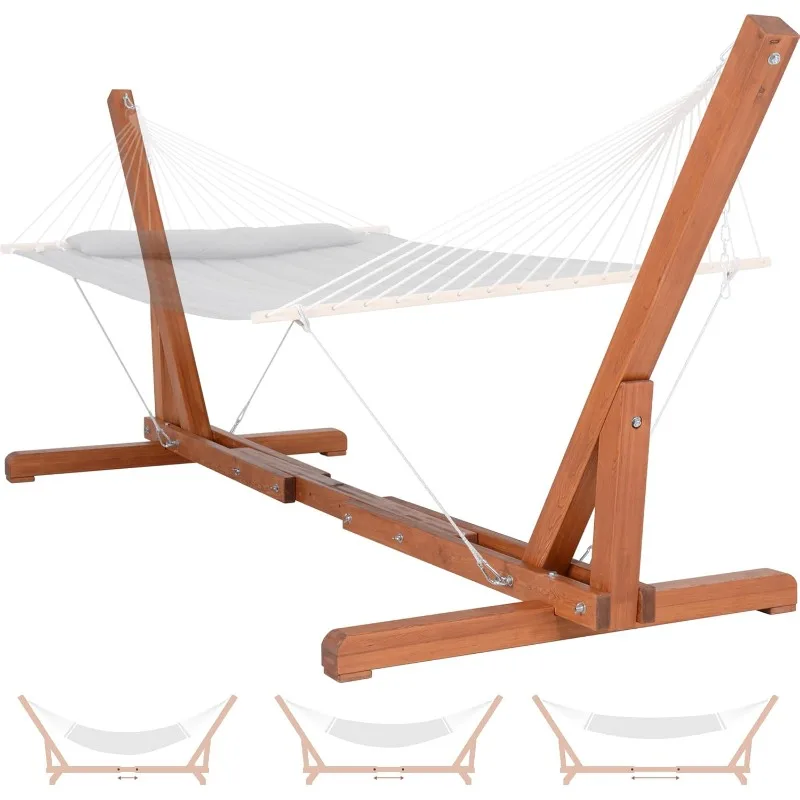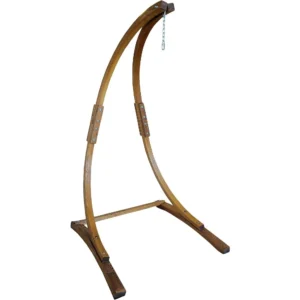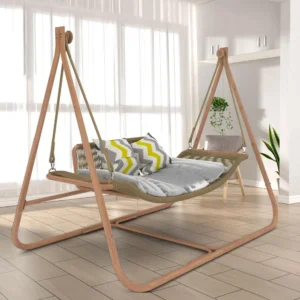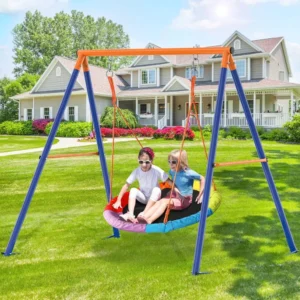Understanding Hammock Stand Durability: What Makes It Last?
Investing in a durable hammock stand is about more than just making a purchase—it’s about securing years of comfortable, worry-free relaxation. A truly durable hammock stand combines quality materials with excellent construction and appropriate weight capacity ratings to create a reliable foundation for your lounging needs.
When it comes to hammock stands, durability matters for several crucial reasons:
- Safety: A sturdy stand prevents unexpected collapses that could lead to injuries
- Long-term value: Quality stands might cost more initially but save money over time by avoiding replacements
- Weather resilience: Durable stands withstand seasonal changes and harsh outdoor conditions
- Performance consistency: A well-built stand maintains its stability and function year after year
The economics of choosing durability are compelling. While budget stands might last only 2-3 years before showing significant deterioration, quality hammock stands routinely provide 10+ years of reliable service. Considering the frequency of use and potential for injury from equipment failure, the investment in durability becomes clearly justified.
Understanding indoor and outdoor hammock placement requirements helps determine exactly what durability features you’ll need most, as different environments place unique demands on your stand’s materials and construction.
Essential Materials for Long-Lasting Hammock Stands
Metal Options
Steel Construction
Steel remains the most common material for hammock stands due to its excellent strength-to-cost ratio. Standard steel provides good durability, but heavy-gauge steel (typically 1.5-inch/38mm tubing or thicker) delivers superior performance for long-term use. Powder coating is essential for steel stands, creating a protective barrier against moisture and extending lifespan by 5+ years compared to painted alternatives.
Stainless Steel Advantages
For coastal environments or areas with high humidity, stainless steel offers exceptional corrosion resistance. While significantly more expensive, stainless stands can last decades with minimal maintenance, making them ideal for permanent outdoor setups near saltwater.
Aluminum Benefits and Limitations
Aluminum stands provide excellent weather resistance naturally without special coatings and offer the advantage of lighter weight. However, they typically support less weight than comparable steel stands and may be more prone to bending under heavy loads. Most quality aluminum stands support around 250-300 pounds (113-136 kg), while similar steel stands often handle 400+ pounds (181+ kg).
Wooden Stand Materials
Our wooden hammock stands collection showcases the natural beauty and strength of various wood options:
Hardwoods (Teak, Oak, Shorea)
These premium woods offer exceptional durability with lifespans of 15-25+ years when properly maintained. Teak contains natural oils that resist water and insects, making it nearly maintenance-free. Oak provides excellent strength but requires more consistent weather protection. Shorea offers similar properties to teak at a lower price point.
Weather-Resistant Softwoods
Cedar and cypress contain natural compounds that resist rot and insect damage, making them excellent choices for outdoor stands. While not as dense as hardwoods, their natural weather resistance often compensates for the slight reduction in strength.
Material Pros and Cons Summary:
- Steel: Strongest and most affordable, but requires protective coating and is heaviest
- Stainless Steel: Most corrosion-resistant but expensive
- Aluminum: Naturally weather-resistant and lightweight, but supports less weight
- Hardwoods: Beautiful and durable but typically require more maintenance and cost more
- Softwoods: Good balance of durability and cost, with natural weather resistance
Critical Construction Features That Ensure Longevity
The materials chosen for a hammock stand tell only part of the durability story—how those materials are assembled makes an equally significant difference in longevity. Here are the construction elements that separate truly durable stands from the rest:
Connection Quality
Welds vs. Mechanical Connections
Quality welds appear smooth, even, and completely seal joints with no visible gaps or bubbles. Inferior welds look uneven, porous, or inconsistently sized. For metal stands, fully welded connections typically outlast bolted connections, which can loosen over time. However, high-quality bolted connections with locking mechanisms offer the advantage of easy disassembly for storage.
Joint Integrity
The strongest designs distribute force across multiple connection points rather than concentrating stress on a single joint. This is why many heavy-duty hammock sets feature reinforced junctions and triangulated support structures.
Structural Elements
Frame Thickness and Profile
Look for tube walls at least 1.5mm thick for steel stands. Square tubing often provides better resistance to twisting forces than round tubing of similar thickness.
Base Design
Wider bases improve stability significantly. Quality stands feature bases extending at least 30-40% of the stand’s length on each side. Look for feet or contact points that distribute weight evenly and prevent sinking into soft ground.
Hardware Quality
The durability chain is only as strong as its weakest link—often the hardware:
- Stainless steel hardware resists corrosion far better than standard zinc-plated alternatives
- Hardware should be at least Grade 5 or higher for optimal strength
- Lock washers or nylon locking nuts prevent loosening from repeated use
- Oversized washers distribute force better at connection points
Assembly Design
Stands designed with fewer parts generally maintain their integrity longer. Each connection point represents a potential failure spot over time. Quality designs minimize unnecessary parts while maximizing structural integrity.
Weatherproofing Features: Protection Against the Elements
Even the best materials and construction need proper protection against weather to ensure maximum lifespan. Knowing if it’s okay to leave a hammock outside depends largely on these weatherproofing features:
Metal Stand Protection
Powder Coating Excellence
Professional powder coating provides superior protection compared to standard paint, creating a tough barrier that typically lasts 5-10 years before needing touch-ups. Quality powder coatings measure at least 2-3 mils (0.002-0.003 inches) thick and resist chipping and UV damage.
Galvanization Options
Hot-dipped galvanized steel offers exceptional rust protection with a typical lifespan of 15+ years in normal outdoor conditions. Though less attractive than powder coating, it provides superior protection for stands in consistently wet environments.
Paint Quality Considerations
If choosing a painted stand, look for marine-grade or outdoor-specific formulations with UV inhibitors. Painted finishes typically require touch-ups every 1-2 years.
Wood Treatment Methods
Sealants and Finishes
Marine-grade sealants offer the best protection for wooden stands, creating a water-resistant barrier that prevents moisture absorption. These typically need reapplication every 1-2 years depending on exposure.
Oil-Based vs. Water-Based Protections
Oil-based treatments penetrate deeper into the wood for longer protection but require more careful application. Water-based options are easier to apply but generally need more frequent reapplication (annually vs. every 2-3 years for quality oil-based products).
Special Climate Considerations
Coastal Environments
For seaside locations, choose either stainless steel or specially treated woods with marine-grade finishes. Standard steel stands, even when powder-coated, typically last only half as long in salt-spray environments.
High UV Exposure
In sunny locations, UV protection becomes critical. Look for UV-inhibiting coatings on metal stands and UV-resistant sealants for wood stands to prevent degradation from constant sun exposure.
Weight Capacity and Stability: The Safety Foundation
Understanding proper weight capacity is fundamental to both safety and durability. A stand forced to support weights beyond its design limits will fail prematurely, even if constructed from quality materials.
Weight Rating Considerations
Static vs. Dynamic Load
Static load refers to the weight at rest, while dynamic load includes movement forces that can temporarily increase strain by 1.5-2 times the static weight. Quality manufacturers account for this by building in safety margins.
Calculating Your Needs
As a rule of thumb, choose a stand rated for at least 50-100 pounds (23-45 kg) more than the combined weight of all intended users. For example:
– 250 lb (113 kg) person → Look for 350-400 lb (159-181 kg) capacity stand
– Couples sharing a hammock → Double the weight capacity needed
Stability Features
Base Width and Design
Wider bases with multiple ground contact points provide superior stability. The base should extend significantly beyond the hammock attachment points on both sides.
Center of Gravity
Lower-profile stands inherently offer better stability. For taller stands, look for wider bases that compensate for the higher center of gravity.
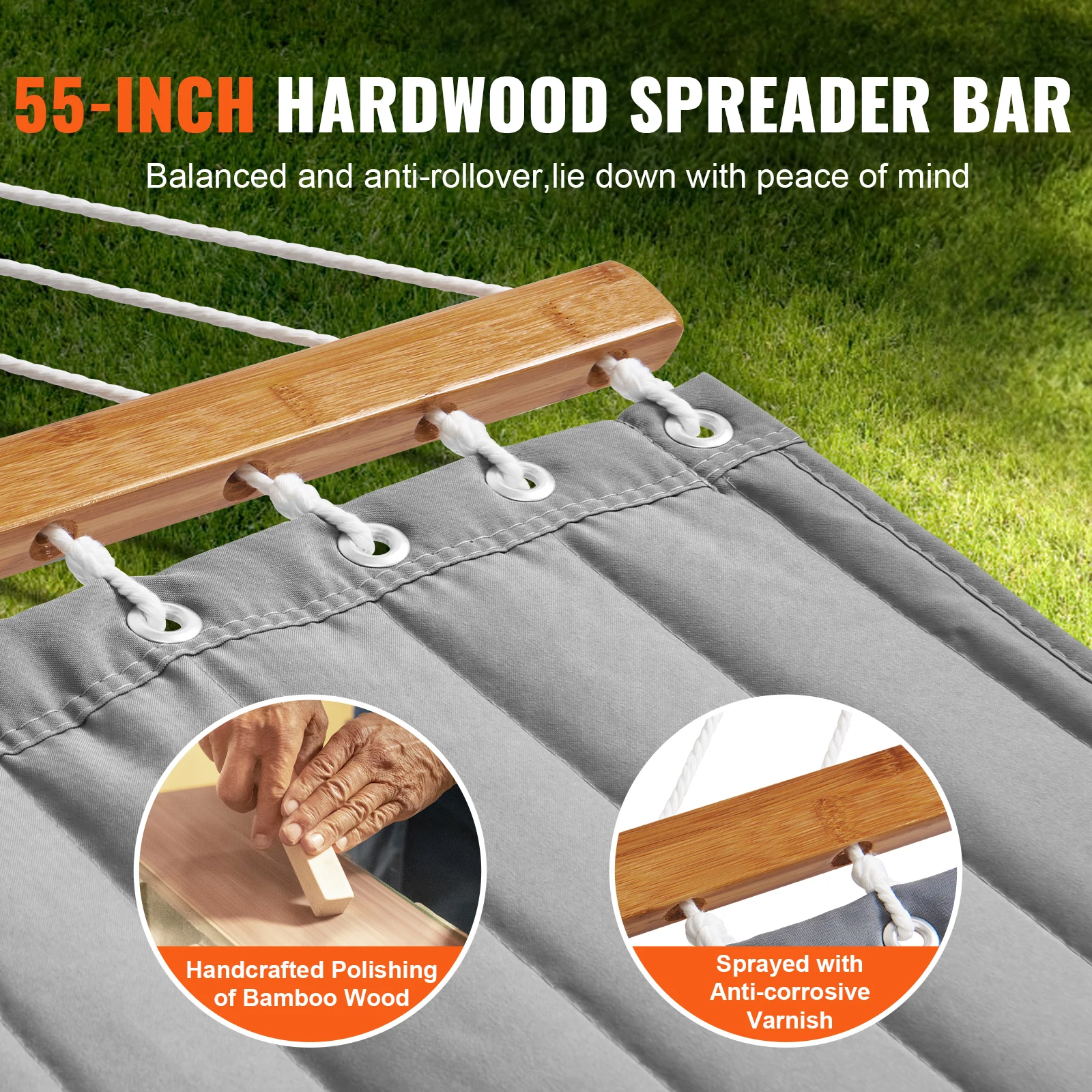
Understanding A-frame hammock stands’ engineering strength helps explain why they’re often rated for higher weight capacities—their triangulated design efficiently distributes forces to multiple support points.
Warning Signs of Capacity Issues
Be alert to these indicators that a stand may be approaching its weight limits:
* Visible flexing under normal use
* Creaking or unusual sounds when getting in or out
* Gradual leaning or deformation over time
* Connections that require frequent tightening
Comparing Stand Types: Durability Across Designs
Different hammock stand designs offer varying advantages in durability, stability, and versatility:
A-Frame/Traditional Stands
These classic designs feature excellent stability due to their triangulated structure. Our A-frame stand hammock sets showcase this time-tested design that efficiently distributes weight across multiple support points. Their wide footprint creates excellent stability, though they typically require more space than other designs.
Best for: Permanent setups, heavy users, maximum stability
Arc/Crescent Stands
These elegant curved designs create a visually appealing profile while maintaining good structural integrity. The arc shape provides natural strength through curved engineering principles. However, stress concentrates at the curve’s apex and base connection points, making quality construction especially important.
Best for: Design-conscious users, moderate weight needs
Multi-Arm/Universal Stands
These adaptable stands accommodate various hammock types and sizes through adjustable attachment points. While versatile, the additional moving parts and connections create more potential failure points over time. Look for locking mechanisms that prevent unintended adjustment.
Best for: Multiple hammock owners, those who change hammock types frequently
Portable/Folding Stands
These lightweight, collapsible options prioritize convenience but typically sacrifice some durability. Quality portable stands use thicker materials at stress points and limit moving parts to essential connections only. Weight capacities usually range 50-100 pounds lower than comparable fixed stands.
Best for: Travel, occasional use, limited storage space
Durability Comparison: At-a-Glance Material Guide
| Material | Rust Resistance | Rot Resistance | Strength | Maintenance | Weight | UV Resistance | Best Design |
|---|---|---|---|---|---|---|---|
| Steel | Low (without coating) | Excellent | Excellent | Moderate | Heavy | Good (with coating) | All types |
| Stainless Steel | Excellent | Excellent | Excellent | Minimal | Heavy | Excellent | All types |
| Aluminum | Excellent | Excellent | Good | Minimal | Light | Excellent | A-frame, Arc |
| Teak | Excellent | Excellent | Very good | Low | Medium | Very good | Arc, A-frame |
| Cedar | Very good | Very good | Good | Moderate | Light | Good | Arc |
| Oak | Moderate | Moderate | Excellent | High | Heavy | Moderate | A-frame |
This comparison helps match your specific environment and needs with the most appropriate material. Consider prioritizing:
– Rust resistance for coastal or high-humidity areas
– Strength for multiple users or larger individuals
– Maintenance requirements based on how much care you’re willing to provide
– Weight if you plan to move the stand occasionally
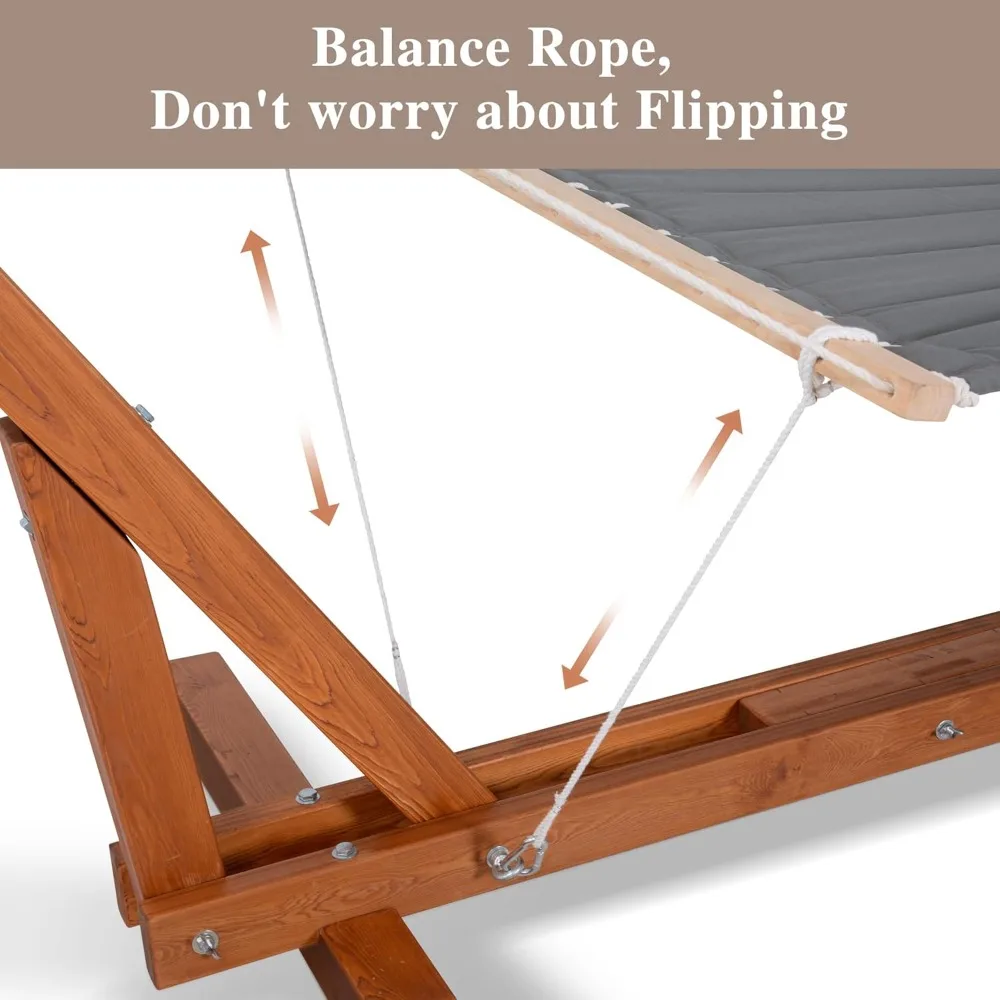
Proper hammock installation requirements and safety guidelines complement these material choices by ensuring the stand is used correctly for maximum durability.
Common Durability Red Flags: What to Avoid
Learning to identify potential durability issues before purchase can save considerable frustration. Watch for these warning signs:
In Product Descriptions
- Vague weight capacity descriptions (e.g., “supports adults” instead of specific numbers)
- Missing material thickness specifications
- Absence of weatherproofing details for outdoor stands
- Unrealistically light weight for claimed capacity
- No mention of construction methods or materials used
Physical Indicators
- Visible gaps or uneven welds at connection points
- Thin-walled tubing that flexes easily
- Painted (rather than powder-coated) steel for outdoor use
- Small or insufficient base footprint
- Minimal or thin connection hardware
Price Considerations
Quality stands typically fall within certain price ranges based on materials and construction. While prices vary, be suspicious of options priced significantly below these general guidelines:
* Basic steel stands: $80-150
* Heavy-duty steel stands: $150-300
* Quality wooden stands: $200-500+
* Stainless steel stands: $300-600+
For additional details on quality construction, our ultimate guide to heavy-duty hammock stands provides in-depth analysis of premium construction techniques.
Essential Maintenance for Maximum Lifespan
Even the most durable hammock stand benefits from proper maintenance. Follow these guidelines to maximize your investment:
Seasonal Inspection Checklist
- Check and tighten all hardware connections
- Inspect welds and joints for early signs of weakness
- Examine protective finishes for chips or wear
- Check wooden components for splits or cracks
- Verify stability and level positioning
Material-Specific Maintenance
Metal Stands:
1. Wash with mild soap and water 2-3 times yearly
2. Touch up any damaged finish promptly with matching paint/coating
3. Apply automotive wax to powder-coated finishes annually for extra protection
4. Keep moving parts lightly lubricated with silicone spray
Wooden Stands:
1. Clean with wood-appropriate cleaner twice yearly
2. Reapply protective finish according to manufacturer recommendations:
* Oil finishes: Every 6-12 months
* Sealants: Every 1-2 years
* Varnish: Every 2-3 years
3. Sand minor damage before refinishing
4. Keep off consistently wet ground with platform or paving stones
Understanding how perfect hammock placement in home and garden affects maintenance needs helps protect your investment by minimizing unnecessary environmental stress.
Smart Shopping: Identifying Quality Before Purchase
Armed with knowledge about materials and construction, use these practical strategies to evaluate hammock stands before buying:
Specification Analysis
- Look for detailed material descriptions (gauge, thickness, treatment processes)
- Verify specific weight capacity ratings, not vague terms
- Check for hardware details (bolt grade, connection types)
- Confirm weatherproofing methods appropriate for your climate
Asking the Right Questions
- “What type of welding is used on the connections?”
- “How thick is the powder coating or protective finish?”
- “What is the actual tube/material thickness?”
- “What maintenance is required and how often?”
Review Evaluation
When reading user reviews, pay special attention to:
* Comments about stability after extended use
* Mentions of rusting or weathering issues
* Notes about ease of assembly (often indicates quality of hardware)
* Reports from users in similar climates or usage patterns
Warranty Assessment
Quality stands typically offer warranties of at least 1-2 years, with premium options extending to 5+ years. Limited lifetime warranties on structural components indicate manufacturer confidence in durability.
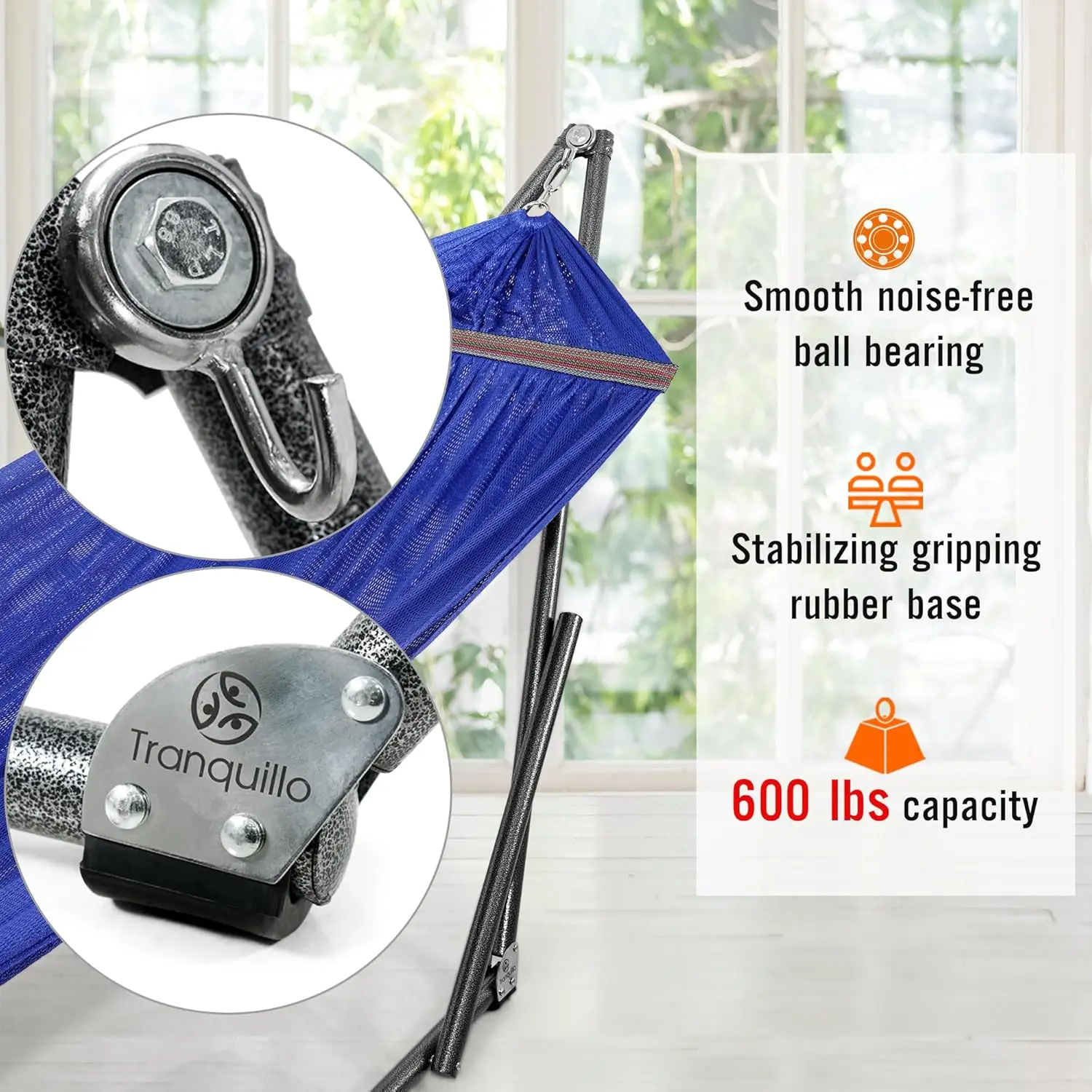
Eco-Friendly Durability: Sustainable Choices
Durability and sustainability often go hand-in-hand when selecting a hammock stand:
Recyclable Materials: Aluminum stands offer excellent end-of-life recyclability, while steel stands can also be recycled but with greater energy requirements.
Certified Woods: Look for FSC (Forest Stewardship Council) certification on wooden stands to ensure responsible harvesting practices.
Environmental Impact: Consider that durable stands reduce waste significantly. A quality stand lasting 10+ years prevents multiple cheaper stands from entering landfills.
Local Materials: Stands made from locally-sourced materials often have lower carbon footprints due to reduced transportation needs.
When properly maintained, sustainable options often match or exceed the durability of conventional alternatives while reducing environmental impact.
Dark Wood Hammock Sets, Porch Swing Chair Sets
$653.82 Select options This product has multiple variants. The options may be chosen on the product pageA-Frame Stand Hammock Sets, Swinging Hammock Chair Sets
$154.62 Select options This product has multiple variants. The options may be chosen on the product pageLight Wood Hammock Sets, Swinging Hammock Chair Sets
$1,359.35 Select options This product has multiple variants. The options may be chosen on the product pageClassic Wooden Stand Hammock Sets, Heavy Duty Hammock Sets
$1,061.68 Select options This product has multiple variants. The options may be chosen on the product pageHammock Sets with Canopy, Heavy Duty Hammock Sets
$286.31 Select options This product has multiple variants. The options may be chosen on the product pageFolding Hammock Sets, Quick Setup Hammock Sets
Price range: $305.52 through $583.27 Select options This product has multiple variants. The options may be chosen on the product page
Is a Portable Stand Still Durable? Balancing Convenience and Longevity
Many buyers wonder if they must sacrifice durability to gain portability. The answer depends on design quality and expectations:
How Portability Affects Durability
Portable stands necessarily include more connection points and moving parts, creating additional potential failure points. However, quality portable hammock stands incorporate design elements that maintain structural integrity despite these requirements:
- Reinforced Pivot Points: Premium portable stands feature extra material thickness at folding mechanisms
- Locking Mechanisms: Quality designs include positive locking systems that prevent unintended collapse
- Weight Capacity Trade-off: Most portable stands support 50-100 pounds less than their stationary counterparts
- Material Considerations: Aluminum offers better durability-to-weight ratio for portable designs
When Portable Makes Sense
- For occasional use rather than daily lounging
- When storage space limits permanent setup options
- For travelers who want hammock comfort away from home
Our folding hammock sets demonstrate how smart engineering can maintain impressive durability even in portable designs.
Can a Hammock Stand Be Both Stylish and Durable?
Aesthetics and durability are not mutually exclusive when manufacturers understand structural engineering principles. In fact, many design elements that create visual appeal can enhance structural integrity:
- The graceful curve of arc stands distributes weight efficiently while creating visual elegance
- Exposed joinery in premium wooden stands showcases craftsmanship while providing structural strength
- Minimalist designs often remove unnecessary components that could otherwise fail
- Contrasting materials (like wood and metal combinations) can create visual interest while utilizing the strengths of each material
The best stands incorporate design elements that serve both aesthetic and structural purposes, rather than sacrificing one for the other.
The Investment Perspective: Cost vs. Durability Analysis
When evaluating hammock stands from a financial perspective, consider the total cost of ownership rather than just the initial price:
A quality steel stand priced at $250 with a 10-year lifespan costs effectively $25 per year. Meanwhile, a budget $80 stand that lasts only 2 years costs $40 per year—making it more expensive over time despite the lower initial investment.
Additionally, consider these financial factors:
* Higher-end stands often retain resale value better
* Replacement costs include not just the stand but the time and effort to research, purchase, and assemble a new one
* Some premium stands (particularly wooden ones) appreciate aesthetically as they age, adding value to outdoor spaces
For most users who enjoy regular hammock time, investing in durability provides better long-term value and more consistent enjoyment than cycling through multiple budget options.
By considering materials, construction, weatherproofing, and maintenance needs, you can select a hammock stand that delivers years of relaxation—turning your outdoor or indoor space into a personal retreat built to last.

